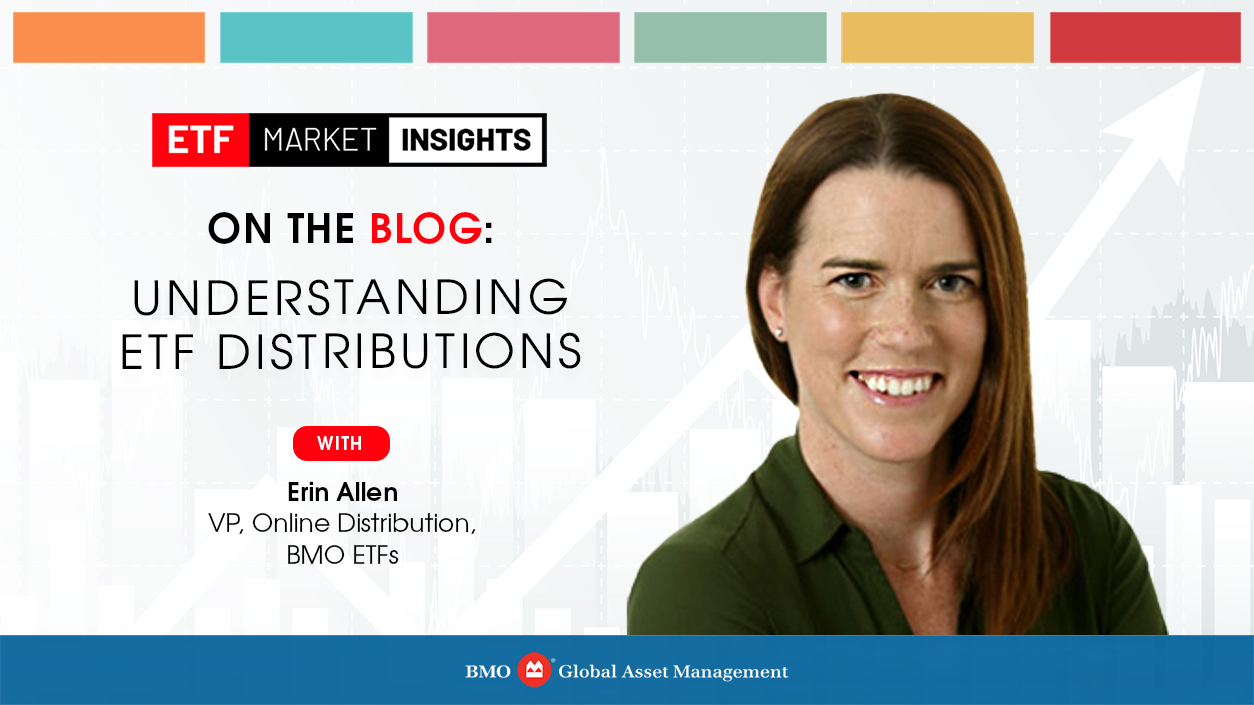
Investors continue to use ETFs in their portfolios due to their ease of access, diversification and lower costs compared to traditional mutual funds. One aspect of ETF investing that investors should understand is distributions; what are the different types, where to find information, timing of distributions, and what are the factors you should consider around ETF distributions.
What Are ETF Distributions?
ETF distributions are payments made by an ETF to its shareholders. In non-registered accounts, these distributions are taxable to the investor in the year they are received and may include dividends, interest income, capital gains, and return of capital (which is non-taxable). ETF distributions are typically paid out in cash, however year-end distributions may be received “in-kind” and reinvested. Whether a distribution is received in cash or reinvested, it has the same tax impact for a non-registered investor. The tax impact will depend on the type of distribution received (interest, dividends, or capital gains) and will be reflected on an investor’s year-end tax slip.
Types of ETF Distributions
- Canadian Dividends: Dividend distributions occur when an ETF invests in Canadian equity securities that pay dividends. Canadian residents qualify for a dividend tax credit, if the ETF invests in Canadian securities that pays dividends.
- Interest and Other Income: Fixed Income ETFs earn interest on their investments in bonds and other debt obligations. When an ETF pays our distributions as interest and other income, distributions are taxed as ordinary income.
- Capital Gains: An ETF may incur capital gains if an underlying security in the ETF is sold for more that its purchase price. Only 50% of the capital gain is included in the investor’s taxable income.
- Foreign Income & Foreign Tax Paid: When an ETF earns dividends or interest on foreign investments the ETF may have to pay foreign withholding tax. When an ETF distributes this foreign income, a Canadian investor may be able to claim a foreign tax credit in respect of the associated foreign tax paid by the ETF.
- Return of Capital: An ETF may distribute a portion of your initial investment. This is considered return of capital and is not taxable to investors. However, such a distribution will decrease the ACB (adjusted cost base) of the investor’s units. When the investor sells the ETF units the lower ACB will increase the capital gain (or decrease the capital loss) that would otherwise be realized on the sale.
- Reinvested “Phantom” Distributions: Phantom distributions are the reinvestment of unpaid capital gains that an ETF may realize if an underlying security in the ETF’s portfolios sold for more than its purchase price. Learn More Here
What triggers a Capital Gain?
An ETF could incur a capital gain if one of the following events occur:
- Performance – If the ETF experiences positive returns since purchase and the underlying investment is sold, the ETF could realize a capital gain.
- Corporate Action – When a merger or acquisition occurs resulting in a disposition of one of the underlying holdings, the ETF may realize a capital gain.
- Portfolio Rebalancing – When this occurs, the ETF will trade the underlying securities, which could result in a capital gain.
More on Return of Capital (ROC)
Any distribution that is paid out in excess of taxable income is classified as ROC. For cash distributions paid throughout the year, BMO ETFs generally distributes based on the underlying portfolio yield less expenses. This benefits investors by providing greater certainty on the payout. As the ETF grows, the income earned is allocated across unitholders.
The important consideration for ROC, is whether it impacts the sustainability of the distribution. We define good ROC as sustainable, where the invested capital is not depleted over time. We define bad ROC as dipping into the invested capital to support the distribution, which leaves less investment for future years.
Timing of Distributions
Distributions are paid to investors based on the number of units they hold of an ETF on its “record date”. The record date is generally the business day prior to the distribution date. The frequency and amount of distributions can vary between different ETFs. Investors should review an ETFs prospectus or website to understand the distribution policy and schedule before investing.
If you are purchasing an ETF and would like to receive that month’s distribution you must do so before the ETF’s “ex-date”, this will ensure you are on record for the payment.
Key dates, including payment date and the payment amounts are posted on the ETF issuers website under “Distributions”. Here you will find full transparency regarding previous payments, as well as the tax parameters or breakdown of previous years’ distributions.
Considerations for Investors
Understanding and monitoring ETF distributions is crucial for investors for several reasons:
- Income Generation: Some investors use distributions to fund their expenses and need that monthly cash flow in their portfolios. Regular consistent distributions can be important in meeting your income needs which can be particularly important in retirement.
- Tax Implications: ETF distributions have tax implications for investors. Investors should be aware of the tax consequences of holding ETFs, especially if they are investing in non-registered accounts. Investors will receive their T3 in the beginning of the following year which will outline what needs to be included in their annual tax filing.
- Yield vs. Total Return: Total return is a performance measure that reflects the actual rate of return of an investment, and includes interest, capital gains, dividends and distributions realized over the period. Total Return investors are focused on the overall growth of their investment, including capital appreciation and distributions. Generally yield or income focused investors are looking to preserve their capital and generate cash flow; these investors should be careful to avoid yield trap investments that may grind the NAV of their investment.
Different ETFs have varying yield profiles, and investors should align their investment objectives accordingly.
- Tax Efficiency: Some ETFs are structured to be more tax-efficient than others. ETFs that employ strategies like sampling or in-kind transfers can minimize capital gains distributions, resulting in potentially lower tax liabilities for investors in non-registered accounts.
- Withholding Tax: Dividend income received from non-Canadian investments may be subject to withholding taxes. Foreign tax credits can be claimed for investments held in taxable, non-registered accounts. If international securities are held indirectly through a U.S. ETF, withholding taxes may not be fully recoverable. If a Canadian resident holds a US listed ETF that holds international securities in a non-registered account, investors could be subject to paying two levels of withholding tax. BMO ETFs avoid this unrecoverable tax by holding their underlying securities directly, allowing for foreign tax credits to be claimed.
- Reinvestment: ETFs are eligible for the Dividend Reinvestment Plan (aka DRIP). Reinvesting your distributions will allow your money to compound and grow faster than if you were to take the distributions in cash. Once the plan is set up with your broker the process is automatic – and you will not have to pay commissions when you reinvest the proceeds into more units. Using the DRIP feature also means you are effectively dollar cost averaging into your chosen investment.
It is important to be prepared and plan for effective tax management. Each year ETF investors can expect to receive tax forms from their respective brokerages.
As an investor, your primary focus should be on the total return of your portfolio and the tax efficiency of your return depending on your type of account, taxable or non-taxable.
Disclaimer:
This material is for information purposes. The information contained herein is not, and should not be construed as, investment, tax or legal advice to any party. Particular investments and/or trading strategies should be evaluated relative to the individual’s investment objectives and professional advice should be obtained with respect to any circumstance. The viewpoints expressed by the author represents their assessment of the markets at the time of publication. Those views are subject to change without notice at any time. The information provided herein does not constitute a solicitation of an offer to buy, or an offer to sell securities nor should the information be relied upon as investment advice. Past performance is no guarantee of future results. This communication is intended for informational purposes only. Commissions, management fees and expenses all may be associated with investments in exchange traded funds. Please read the ETF Facts or prospectus of the BMO ETFs before investing. Exchange traded funds are not guaranteed, their values change frequently and past performance may not be repeated. For a summary of the risks of an investment in the BMO ETFs, please see the specific risks set out in the BMO ETF’s prospectus. BMO ETFs trade like stocks, fluctuate in market value and may trade at a discount to their net asset value, which may increase the risk of loss. Distributions are not guaranteed and are subject to change and/or elimination. BMO ETFs are managed by BMO Asset Management Inc., which is an investment fund manager and a portfolio manager, and a separate legal entity from Bank of Montreal. ®/™Registered trademarks/trademark of Bank of Montreal, used under licence.



















































